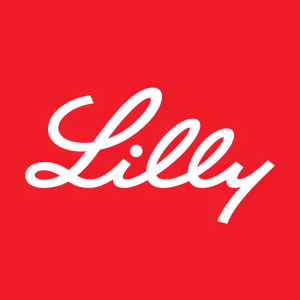Lilly to Present New Data from Oncology Portfolio at ESMO Congress
Rhea-AI Summary
New research from Eli Lilly Company (NYSE: LLY) will be showcased at the ESMO Congress 2021 (September 16-21). Key findings include:
- Verzenio: Studies on high-risk early breast cancer and advanced breast cancer.
- Retevmo: Real-world data on medullary thyroid cancer and RET testing patterns in Europe.
- CYRAMZA: Insights on metastatic NSCLC and the impact of TP53 status.
- Sintilimab: Phase III trial results for esophageal and gastric cancers.
Posters available starting September 16, with mini-oral presentations on September 17.
Positive
- None.
Negative
- None.
News Market Reaction 1 Alert
On the day this news was published, LLY declined 0.64%, reflecting a mild negative market reaction.
Data tracked by StockTitan Argus on the day of publication.
INDIANAPOLIS, Sept. 13, 2021 /PRNewswire/ -- New data from various studies of Eli Lilly and Company's (NYSE: LLY) Verzenio® (abemaciclib), Retevmo® (selpercatinib) and CYRAMZA® (ramucirumab) will be presented at the European Society for Medical Oncology (ESMO) Congress 2021, to be held virtually September 16-21. Data will also be presented on Innovent's sintilimab, for which Lilly has an exclusive license for geographies outside of China.
Details on poster presentations for Verzenio, Retevmo and CYRAMZA are shared below.
Medicine | Abstract Title | Presentation Details |
Verzenio (abemaciclib) | Adjuvant endocrine therapy combined with abemaciclib in monarchE patients with high-risk early breast cancer: Disease characteristics and endocrine therapy choice by menopausal status | Abstract #: 153P Poster available: September 16 at 08:30 CEST |
Verzenio (abemaciclib) | Abemaciclib plus fulvestrant in participants with HR+/HER2- advanced breast cancer: A pooled analysis of the endocrine therapy naïve (EN) participants in MONARCH 2 | Abstract #: 241P Poster available: September 16 at 08:30 CEST |
Retevmo (selpercatinib) | Real-world study of REarranged during Transfection [RET] testing in patients [pts] with medullary thyroid cancer [MTC] in Europe [EU5] | Abstract #: 1751P Poster available: September 16 at 08:30 CEST |
Retevmo (selpercatinib) | Characteristics and treatment [tx] patterns in patients [pts] with medullary thyroid cancer [MTC] with and without REarranged during Transfection [RET] mutations in Europe | Abstract #: 1752P Poster available: September 16 at 08:30 CEST |
Retevmo (selpercatinib) | REarranged during Transfection [RET] gene fusion testing patterns for patients [pts] with papillary thyroid cancer [PTC] across five European countries | Abstract #: 1753P Poster available: September 16 at 08:30 CEST |
CYRAMZA (ramucirumab) | RELAY, ramucirumab plus erlotinib (RAM+ERL) in untreated metastatic EGFR-mutant NSCLC (EGFR+ NSCLC): Association between TP53 status and clinical outcome | Abstract #: 1209P Poster available: September 16 at 08:30 CEST |
Details on presentations for sintilimab are shared below. | ||
sintilimab | Sintilimab plus chemotherapy versus chemotherapy as first-line therapy in patients with advanced or metastatic esophageal squamous cell cancer: First results of the phase III ORIENT-15 study | Abstract #: LBA52 Mini-Oral Presentation: September 17, 17:30 – 17:35 CEST |
sintilimab | Sintilimab plus chemotherapy (chemo) versus chemo as first-line treatment for advanced gastric or gastroesophageal junction (G/GEJ) adenocarcinoma (ORIENT-16): First results of a randomized, double-blind, phase III study | Abstract #: LBA53 Mini-Oral Presentation: September 17, 17:35 – 17:40 CEST |
Notes to Editors
About Verzenio® (abemaciclib)
Verzenio (abemaciclib) is an inhibitor of cyclin-dependent kinases (CDK)4 & 6, which are activated by binding to D-cyclins. In estrogen receptor-positive (ER+) breast cancer cell lines, cyclin D1 and CDK4 & 6 promote phosphorylation of the retinoblastoma protein (Rb), cell cycle progression, and cell proliferation.
In vitro, continuous exposure to Verzenio inhibited Rb phosphorylation and blocked progression from G1 to S phase of the cell cycle, resulting in senescence and apoptosis (cell death). Preclinically, Verzenio dosed daily without interruption resulted in reduction of tumor size. Inhibiting CDK4 & 6 in healthy cells can result in side effects, some of which may be serious. Clinical evidence also suggests that Verzenio crosses the blood-brain barrier. In patients with advanced cancer, including breast cancer, concentrations of Verzenio and its active metabolites (M2 and M20) in cerebrospinal fluid are comparable to unbound plasma concentrations.
Verzenio is Lilly's first solid oral dosage form to be made using a faster, more efficient process known as continuous manufacturing. Continuous manufacturing is a new and advanced type of manufacturing within the pharmaceutical industry, and Lilly is one of the first companies to use this technology.
INDICATION FOR VERZENIO
Verzenio is indicated for the treatment of HR+, HER2- advanced or metastatic breast cancer:
- in combination with an aromatase inhibitor for postmenopausal women as initial endocrine-based therapy
- in combination with fulvestrant for women with disease progression following endocrine therapy
- as a single agent for adult patients with disease progression following endocrine therapy and prior chemotherapy in the metastatic setting
About Retevmo® (selpercatinib)
Retevmo (selpercatinib, capsules 40mg, 80mg; formerly known as LOXO-292) (pronounced reh-TEHV-moh) is a selective and potent RET kinase inhibitor. Retevmo may affect both tumor cells and healthy cells, which can result in side effects. RET-driver alterations are predominantly mutually exclusive from other oncogenic drivers. Retevmo is an U.S. FDA-approved oral prescription medicine, 120 mg or 160 mg dependent on weight (<50 kg or ≥50 kg, respectively), taken twice daily until disease progression or unacceptable toxicity.1 Continued approval may be contingent upon verification and description of clinical benefit in confirmatory trials.
INDICATIONS FOR RETEVMO
Retevmo is indicated for the treatment of adult patients with metastatic rearranged during transfection fusion-positive non-small cell lung cancer (NSCLC), and the treatment of adult and pediatric patients 12 years of age and older with advanced or metastatic RET-mutant medullary thyroid cancer (MTC) who require systemic therapy, or advanced or metastatic RET fusion-positive thyroid cancer who require systemic therapy and who are radioactive iodine-refractory (if radioactive iodine is appropriate). Retevmo was approved under the FDA's Accelerated Approval regulations based on the LIBRETTO-001 Phase 1/2 trial's endpoints of objective response rate (ORR) and duration of response (DoR).
About CYRAMZA® (ramucirumab)
In the U.S., CYRAMZA (ramucirumab) has six FDA approvals to treat four different types of cancers. CYRAMZA is being investigated in a broad global development program that has enrolled more than 15,000 patients across more than 100 trials worldwide. These include several studies investigating CYRAMZA in combination with other anti-cancer therapies for the treatment of multiple tumor types. To date, more than 150,000 patients have been treated with CYRAMZA.
CYRAMZA is an antiangiogenic therapy. It is a vascular endothelial growth factor (VEGF) Receptor 2 antagonist that binds specifically to VEGFR-2, thereby blocking the binding of the receptor ligands (VEGF-A, VEGF-C, and VEGF-D) – which may slow tumor growth. CYRAMZA inhibited angiogenesis in an in vivo animal model.
U.S. INDICATIONS FOR CYRAMZA
Gastric Cancer
CYRAMZA, as a single agent, or in combination with paclitaxel, is indicated for the treatment of patients with advanced or metastatic gastric or gastroesophageal junction (GEJ) adenocarcinoma with disease progression on or after prior fluoropyrimidine- or platinum-containing chemotherapy.
Non-Small Cell Lung Cancer
CYRAMZA, in combination with erlotinib, for first-line treatment of metastatic non-small cell lung cancer with epidermal growth factor receptor (EGFR) exon 19 deletions or exon 21 (L858R) mutations.
CYRAMZA, in combination with docetaxel, is indicated for the treatment of patients with metastatic non-small cell lung cancer (NSCLC) with disease progression on or after platinum-based chemotherapy. Patients with epidermal growth factor receptor (EGFR) or anaplastic lymphoma kinase (ALK) genomic tumor aberrations should have disease progression on FDA-approved therapy for these aberrations prior to receiving CYRAMZA.
Colorectal Cancer
CYRAMZA, in combination with FOLFIRI (irinotecan, folinic acid, and fluorouracil), is indicated for the treatment of patients with metastatic colorectal cancer (mCRC) with disease progression on or after prior therapy with bevacizumab, oxaliplatin, and a fluoropyrimidine.
Hepatocellular Carcinoma
CYRAMZA, as a single agent, is indicated for the treatment of patients with hepatocellular carcinoma (HCC) who have an alpha-fetoprotein (AFP) of ≥400 ng/mL and have been treated with sorafenib.
IMPORTANT SAFETY INFORMATION FOR VERZENIO (abemaciclib)
Diarrhea occurred in
Diarrhea incidence was greatest during the first month of Verzenio dosing. In MONARCH 3, the median time to onset of the first diarrhea event was 8 days, and the median duration of diarrhea for Grades 2 and 3 were 11 and 8 days, respectively. In MONARCH 2, the median time to onset of the first diarrhea event was 6 days, and the median duration of diarrhea for Grades 2 and 3 were 9 days and 6 days, respectively. In MONARCH 3,
Instruct patients that at the first sign of loose stools, they should start antidiarrheal therapy such as loperamide, increase oral fluids, and notify their healthcare provider for further instructions and appropriate follow-up. For Grade 3 or 4 diarrhea, or diarrhea that requires hospitalization, discontinue Verzenio until toxicity resolves to ≤Grade 1, and then resume Verzenio at the next lower dose.
Neutropenia occurred in
Monitor complete blood counts prior to the start of Verzenio therapy, every 2 weeks for the first 2 months, monthly for the next 2 months, and as clinically indicated. Dose interruption, dose reduction, or delay in starting treatment cycles is recommended for patients who develop Grade 3 or 4 neutropenia.
Febrile neutropenia has been reported in <
Severe, life-threatening, or fatal interstitial lung disease (ILD) and/or pneumonitis can occur in patients treated with Verzenio and other CDK4/6 inhibitors. Across clinical trials (MONARCH 1, MONARCH 2, MONARCH 3),
Monitor patients for pulmonary symptoms indicative of ILD/pneumonitis. Symptoms may include hypoxia, cough, dyspnea, or interstitial infiltrates on radiologic exams. Infectious, neoplastic, and other causes for such symptoms should be excluded by means of appropriate investigations.
Dose interruption or dose reduction is recommended in patients who develop persistent or recurrent Grade 2 ILD/pneumonitis. Permanently discontinue Verzenio in all patients with grade 3 or 4 ILD/pneumonitis.
Grade ≥3 increases in alanine aminotransferase (ALT) (
In MONARCH 3, for patients receiving Verzenio plus an aromatase inhibitor with Grade ≥3 increases in ALT or AST, median time to onset was 61 and 71 days, respectively, and median time to resolution to Grade <3 was 14 and 15 days, respectively. In MONARCH 2, for patients receiving Verzenio plus fulvestrant with Grade ≥3 increases in ALT or AST, median time to onset was 57 and 185 days, respectively, and median time to resolution to Grade <3 was 14 and 13 days, respectively.
For assessment of potential hepatotoxicity, monitor liver function tests (LFTs) prior to the start of Verzenio therapy, every 2 weeks for the first 2 months, monthly for the next 2 months, and as clinically indicated. Dose interruption, dose reduction, dose discontinuation, or delay in starting treatment cycles is recommended for patients who develop persistent or recurrent Grade 2, or Grade 3 or 4, hepatic transaminase elevation.
Venous thromboembolic events were reported in
Verzenio can cause fetal harm when administered to a pregnant woman based on findings from animal studies and the mechanism of action. In animal reproduction studies, administration of abemaciclib to pregnant rats during the period of organogenesis caused teratogenicity and decreased fetal weight at maternal exposures that were similar to the human clinical exposure based on area under the curve (AUC) at the maximum recommended human dose. Advise pregnant women of the potential risk to a fetus. Advise females of reproductive potential to use effective contraception during treatment with Verzenio and for at least 3 weeks after the last dose. There are no data on the presence of Verzenio in human milk or its effects on the breastfed child or on milk production. Advise lactating women not to breastfeed during Verzenio treatment and for at least 3 weeks after the last dose because of the potential for serious adverse reactions in breastfed infants. Based on findings in animals, Verzenio may impair fertility in males of reproductive potential.
The most common adverse reactions (all grades, ≥
The most common adverse reactions (all grades, ≥
The most common adverse reactions (all grades, ≥
The most frequently reported ≥
The most frequently reported ≥
The most frequently reported ≥
Lab abnormalities (all grades; Grade 3 or 4) for MONARCH 3 in ≥
Lab abnormalities (all grades; Grade 3 or 4) for MONARCH 2 in ≥
Lab abnormalities (all grades; Grade 3 or 4) for MONARCH 1 were increased serum creatinine (
Strong and moderate CYP3A inhibitors increased the exposure of abemaciclib plus its active metabolites to a clinically meaningful extent and may lead to increased toxicity. Avoid concomitant use of the strong CYP3A inhibitor ketoconazole. Ketoconazole is predicted to increase the AUC of abemaciclib by up to 16-fold. In patients with recommended starting doses of 200 mg twice daily or 150 mg twice daily, reduce the Verzenio dose to 100 mg twice daily with concomitant use of strong CYP3A inhibitors other than ketoconazole. In patients who have had a dose reduction to 100 mg twice daily due to adverse reactions, further reduce the Verzenio dose to 50 mg twice daily with concomitant use of strong CYP3A inhibitors. If a patient taking Verzenio discontinues a strong CYP3A inhibitor, increase the Verzenio dose (after 3 to 5 half-lives of the inhibitor) to the dose that was used before starting the inhibitor. With concomitant use of moderate CYP3A inhibitors, monitor for adverse reactions and consider reducing the Verzenio dose in 50 mg decrements. Patients should avoid grapefruit products.
Avoid concomitant use of strong or moderate CYP3A inducers and consider alternative agents. Coadministration of strong or moderate CYP3A inducers decreased the plasma concentrations of abemaciclib plus its active metabolites and may lead to reduced activity.
With severe hepatic impairment (Child-Pugh Class C), reduce the Verzenio dosing frequency to once daily. The pharmacokinetics of Verzenio in patients with severe renal impairment (CLcr <30 mL/min), end stage renal disease, or in patients on dialysis is unknown. No dosage adjustments are necessary in patients with mild or moderate hepatic (Child-Pugh A or B) and/or renal impairment (CLcr ≥30-89 mL/min).
AL HCP ISI 17SEP2019
Please see full Prescribing Information for Verzenio.
IMPORTANT SAFETY INFORMATION FOR RETEVMO® (selpercatinib)
Hepatotoxicity: Serious hepatic adverse reactions occurred in
Hypertension occurred in
Retevmo can cause concentration-dependent QT interval prolongation. An increase in QTcF interval to >500 ms was measured in
Serious, including fatal, hemorrhagic events can occur with Retevmo. Grade ≥3 hemorrhagic events occurred in
Hypersensitivity occurred in
Tumor lysis syndrome (TLS) occurred in
Impaired wound healing can occur in patients who receive drugs that inhibit the vascular endothelial growth factor (VEGF) signaling pathway. Therefore, Retevmo has the potential to adversely affect wound healing. Withhold Retevmo for at least 7 days prior to elective surgery. Do not administer for at least 2 weeks following major surgery and until adequate wound healing. The safety of resumption of Retevmo after resolution of wound healing complications has not been established.
Based on data from animal reproduction studies and its mechanism of action, Retevmo can cause fetal harm when administered to a pregnant woman. Administration of selpercatinib to pregnant rats during organogenesis at maternal exposures that were approximately equal to those observed at the recommended human dose of 160 mg twice daily resulted in embryolethality and malformations. Advise pregnant women of the potential risk to a fetus. Advise females of reproductive potential and males with female partners of reproductive potential to use effective contraception during treatment with Retevmo and for at least 1 week after the final dose. There are no data on the presence of selpercatinib or its metabolites in human milk or on their effects on the breastfed child or on milk production. Because of the potential for serious adverse reactions in breastfed children, advise women not to breastfeed during treatment with Retevmo and for 1 week after the final dose.
Severe adverse reactions (Grade 3-4) occurring in ≥
Serious adverse reactions occurred in
Fatal adverse reactions occurred in
Common adverse reactions (all grades) occurring in ≥
Laboratory abnormalities (all grades; Grade 3-4) ≥
Concomitant use of acid-reducing agents decreases selpercatinib plasma concentrations which may reduce Retevmo anti-tumor activity. Avoid concomitant use of proton-pump inhibitors (PPIs), histamine-2 (H2) receptor antagonists, and locally-acting antacids with Retevmo. If coadministration cannot be avoided, take Retevmo with food (with a PPI) or modify its administration time (with a H2 receptor antagonist or a locally-acting antacid).
Concomitant use of strong and moderate CYP3A inhibitors increases selpercatinib plasma concentrations which may increase the risk of Retevmo adverse reactions including QTc interval prolongation. Avoid concomitant use of strong and moderate CYP3A inhibitors with Retevmo. If concomitant use of a strong or moderate CYP3A inhibitor cannot be avoided, reduce the Retevmo dosage as recommended and monitor the QT interval with ECGs more frequently.
Concomitant use of strong and moderate CYP3A inducers decreases selpercatinib plasma concentrations which may reduce Retevmo anti-tumor activity. Avoid coadministration of Retevmo with strong and moderate CYP3A inducers.
Concomitant use of Retevmo with CYP2C8 and CYP3A substrates increases their plasma concentrations which may increase the risk of adverse reactions related to these substrates. Avoid coadministration of Retevmo with CYP2C8 and CYP3A substrates where minimal concentration changes may lead to increased adverse reactions. If coadministration cannot be avoided, follow recommendations for CYP2C8 and CYP3A substrates provided in their approved product labeling.
The safety and effectiveness of Retevmo have not been established in pediatric patients less than 12 years of age. The safety and effectiveness of Retevmo have been established in pediatric patients aged 12 years and older for medullary thyroid cancer (MTC) who require systemic therapy and for advanced RET fusion-positive thyroid cancer who require systemic therapy and are radioactive iodine-refractory (if radioactive iodine is appropriate). Use of Retevmo for these indications is supported by evidence from adequate and well-controlled studies in adults with additional pharmacokinetic and safety data in pediatric patients aged 12 years and older. Monitor open growth plates in adolescent patients. Consider interrupting or discontinuing Retevmo if abnormalities occur.
No dosage modification is recommended for patients with mild to severe renal impairment (estimated Glomerular Filtration Rate [eGFR] ≥15 to 89 mL/min, estimated by Modification of Diet in Renal Disease [MDRD] equation). A recommended dosage has not been established for patients with end-stage renal disease.
Reduce the dose when administering Retevmo to patients with severe hepatic impairment (total bilirubin greater than 3 to 10 times upper limit of normal [ULN] and any AST). No dosage modification is recommended for patients with mild or moderate hepatic impairment. Monitor for Retevmo-related adverse reactions in patients with hepatic impairment.
SE HCP ISI All_25MAR2021
Please see full U.S. Prescribing Information for Retevmo.
IMPORTANT SAFETY INFORMATION FOR CYRAMZA® (ramucirumab)
Warnings and Precautions
Hemorrhage
- CYRAMZA increased the risk of hemorrhage and gastrointestinal hemorrhage, including Grade ≥3 hemorrhagic events. In 2137 patients with various cancers treated with CYRAMZA, the incidence of all Grade hemorrhage ranged from 13
-55% . Grade 3-5 hemorrhage incidence ranged from 2-5% . - Patients with gastric cancer receiving nonsteroidal anti-inflammatory drugs (NSAIDs) were excluded from enrollment in REGARD and RAINBOW; therefore, the risk of gastric hemorrhage in CYRAMZA-treated patients with gastric tumors receiving NSAIDs is unknown.
- Patients with NSCLC receiving therapeutic anticoagulation or with evidence of major airway invasion by cancer were excluded from REVEL. In addition, patients with NSCLC with a recent history of gross hemoptysis, those receiving chronic therapy with NSAIDs or other anti-platelet therapy other than once daily aspirin or with radiographic evidence of major blood vessel invasion or intratumor cavitation were excluded from REVEL and RELAY; therefore the risk of pulmonary hemorrhage in these groups of patients is unknown.
- Permanently discontinue CYRAMZA in patients who experience severe (Grade 3 or 4) bleeding.
Gastrointestinal Perforations
- CYRAMZA can increase the risk of gastrointestinal perforation, a potentially fatal event. In 2137 patients with various cancers treated with CYRAMZA, the incidence of all Grade and Grade 3-5 gastrointestinal perforations ranged from <1
-2% . - Permanently discontinue CYRAMZA in patients who experience a gastrointestinal perforation.
Impaired Wound Healing
- CYRAMZA has the potential to adversely affect wound healing. CYRAMZA has not been studied in patients with serious or non-healing wounds.
- Withhold CYRAMZA for 28 days prior to elective surgery. Do not administer CYRAMZA for at least 2 weeks following a major surgical procedure and until adequate wound healing. The safety of resumption of CYRAMZA after resolution of wound healing complications has not been established.
Arterial Thromboembolic Events (ATEs)
- Serious, sometimes fatal, ATEs, including myocardial infarction, cardiac arrest, cerebrovascular accident, and cerebral ischemia, occurred across clinical trials. In 2137 patients with various cancers treated with CYRAMZA, the incidence of all Grade ATE was 1
-3% . Grade 3-5 ATE incidence was <1-2% . - Permanently discontinue CYRAMZA in patients who experience an ATE.
Hypertension
- An increased incidence of severe hypertension occurred in patients receiving CYRAMZA. Across five clinical studies, excluding RELAY, in 1916 patients with various cancers treated with CYRAMZA, the incidence of all Grade hypertension ranged from 11
-26% . Grade 3-5 hypertension incidence ranged from 6-15% . In 221 patients with NSCLC receiving CYRAMZA in combination with erlotinib in the RELAY study, the incidence of new or worsening hypertension was higher (45% ), as was the incidence of Grade 3-5 hypertension (24% ). Of the patients experiencing new or worsening hypertension in RELAY (N=100 CYRAMZA and erlotinib; N=27 placebo and erlotinib),13% of those treated with CYRAMZA and erlotinib required initiation of 3 or more antihypertensive medications compared to4% of patients treated with placebo and erlotinib. - Control hypertension prior to initiating treatment with CYRAMZA. Monitor blood pressure every two weeks or more frequently as indicated during treatment. Withhold CYRAMZA for severe hypertension until medically controlled. Permanently discontinue CYRAMZA for medically significant hypertension that cannot be controlled with antihypertensive therapy or in patients with hypertensive crisis or hypertensive encephalopathy.
Infusion-Related Reactions (IRR)
- IRR, including severe and life-threatening IRR, occurred in CYRAMZA clinical trials. Symptoms of IRR included rigors/tremors, back pain/spasms, chest pain and/or tightness, chills, flushing, dyspnea, wheezing, hypoxia, and paresthesia. In severe cases, symptoms included bronchospasm, supraventricular tachycardia, and hypotension. In 2137 patients with various cancers treated with CYRAMZA in which premedication was recommended or required, the incidence of all Grade IRR ranged from <1-
9% . Grade 3-5 IRR incidence was <1% . - Premedicate prior to each CYRAMZA infusion. Monitor patients during the infusion for signs and symptoms of IRR in a setting with available resuscitation equipment. Reduce the infusion rate by
50% for Grade 1-2 IRR. Permanently discontinue CYRAMZA for Grade 3- 4 IRR.
Worsening of Pre-existing Hepatic Impairment
- Clinical deterioration, manifested by new onset or worsening encephalopathy, ascites, or hepatorenal syndrome, was reported in patients with Child-Pugh B or C cirrhosis who received single agent CYRAMZA. Use CYRAMZA in patients with Child-Pugh B or C cirrhosis only if the potential benefits of treatment are judged to outweigh the risks of clinical deterioration.
- Based on safety data from REACH-2, in patients with Child-Pugh A liver cirrhosis, the pooled incidence of hepatic encephalopathy and hepatorenal syndrome was higher for patients who received CYRAMZA (
6% ) compared to patients who received placebo (0% ).
Posterior Reversible Encephalopathy Syndrome (PRES)
- PRES (also known as Reversible Posterior Leukoencephalopathy Syndrome [RPLS]) has been reported in <
0.1% of 2137 patients with various cancers treated with CYRAMZA. Symptoms of PRES include seizure, headache, nausea/vomiting, blindness, or altered consciousness, with or without associated hypertension. - Permanently discontinue CYRAMZA in patients who develop PRES. Symptoms may resolve or improve within days, although some patients with PRES can experience ongoing neurologic sequelae or death.
Proteinuria Including Nephrotic Syndrome
- In 2137 patients with various cancers treated with CYRAMZA, the incidence of all Grade proteinuria ranged from 3
-34% . Grade ≥3 proteinuria (including 4 patients with nephrotic syndrome) incidence ranged from <1-3% . - Monitor for proteinuria. Withhold CYRAMZA for urine protein levels that are 2 or more grams over 24 hours. Reinitiate CYRAMZA at a reduced dose once the urine protein level returns to less than 2 grams over 24 hours. Permanently discontinue CYRAMZA for urine protein levels greater than 3 grams over 24 hours or in the setting of nephrotic syndrome.
Thyroid Dysfunction
- In 2137 patients with various cancers treated with CYRAMZA, the incidence of Grade 1-2 hypothyroidism ranged from <1
-3% ; there were no reports of Grade 3-5 hypothyroidism. Monitor thyroid function during treatment with CYRAMZA.
Embryo-Fetal Toxicity
- CYRAMZA can cause fetal harm when administered to pregnant women. Advise pregnant women of the potential risk to a fetus. Advise females of reproductive potential to use effective contraception during treatment with CYRAMZA and for 3 months after the last dose.
Lactation
- Because of the potential risk for serious adverse reactions in breastfed children from ramucirumab, advise women not to breastfeed during treatment with CYRAMZA and for 2 months after the last dose.
Adverse Reactions
REGARD:
- The most common adverse reactions (all Grades) observed in single agent CYRAMZA-treated gastric cancer patients at a rate of ≥
5% and ≥2% higher than placebo were hypertension (16% vs8% ), diarrhea (14% vs9% ), headache (9% vs3% ), and hyponatremia (6% vs2% ). - The most common serious adverse reactions with CYRAMZA were anemia (
3.8% ) and intestinal obstruction (2.1% ). Red blood cell transfusions were given to11% of CYRAMZA-treated patients vs8.7% of patients who received placebo. - Clinically relevant adverse reactions reported in ≥
1% and <5% of CYRAMZA-treated patients in REGARD were neutropenia (4.7% ), epistaxis (4.7% ), rash (4.2% ), intestinal obstruction (2.1% ), and arterial thromboembolic events (1.7% ). - Across clinical trials of CYRAMZA administered as a single agent, clinically relevant adverse reactions (including Grade ≥3) reported in CYRAMZA-treated patients included proteinuria, gastrointestinal perforation, and IRR. In REGARD, according to laboratory assessment,
8% of CYRAMZA-treated patients developed proteinuria vs3% of placebo-treated patients. Two patients discontinued CYRAMZA due to proteinuria. The rate of gastrointestinal perforation in REGARD was0.8% and the rate of IRR was0.4% .
RAINBOW:
- The most common adverse reactions (all Grades) observed in patients treated with CYRAMZA with paclitaxel at a rate of ≥
5% and ≥2% higher than placebo with paclitaxel were fatigue/asthenia (57% vs44% ), neutropenia (54% vs31% ), diarrhea (32% vs23% ), epistaxis (31% vs7% ), hypertension (25% vs6% ), peripheral edema (25% vs14% ), stomatitis (20% vs7% ), proteinuria (17% vs6% ), thrombocytopenia (13% vs6% ), hypoalbuminemia (11% vs5% ), and gastrointestinal hemorrhage events (10% vs6% ). - The most common serious adverse reactions with CYRAMZA with paclitaxel were neutropenia (
3.7% ) and febrile neutropenia (2.4% );19% of patients who received CYRAMZA with paclitaxel received granulocyte colony-stimulating factors. - Adverse reactions resulting in discontinuation of any component of the CYRAMZA with paclitaxel combination in ≥
2% of patients in RAINBOW were neutropenia (4% ) and thrombocytopenia (3% ). - Clinically relevant adverse reactions reported in ≥
1% and <5% of patients receiving CYRAMZA with paclitaxel were sepsis (3.1% ), including 5 fatal events, and gastrointestinal perforations (1.2% ), including 1 fatal event.
REVEL:
- The most common adverse reactions (all Grades) observed in patients treated with CYRAMZA with docetaxel at a rate of ≥
5% and ≥2% higher than placebo with docetaxel were neutropenia (55% vs46% ), fatigue/asthenia (55% vs50% ), stomatitis/mucosal inflammation (37% vs19% ), epistaxis (19% vs7% ), febrile neutropenia (16% vs10% ), peripheral edema (16% vs9% ), thrombocytopenia (13% vs5% ), lacrimation increased (13% vs5% ), and hypertension (11% vs5% ). - The most common serious adverse reactions with CYRAMZA with docetaxel were febrile neutropenia (
14% ), pneumonia (6% ), and neutropenia (5% ). The use of granulocyte colony-stimulating factors was42% in CYRAMZA with docetaxel- treated patients versus37% in patients who received placebo with docetaxel. - Treatment discontinuation due to adverse reactions occurred more frequently in CYRAMZA with docetaxel-treated patients (
9% ) than in placebo with docetaxel-treated patients (5% ). The most common adverse reactions leading to treatment discontinuation of CYRAMZA were IRR (0.5% ) and epistaxis (0.3% ). - For patients with non-squamous histology, the overall incidence of pulmonary hemorrhage was
7% and the incidence of Grade ≥3 pulmonary hemorrhage was1% for CYRAMZA with docetaxel compared to6% overall incidence and1% for Grade ≥3 pulmonary hemorrhage for placebo with docetaxel. For patients with squamous histology, the overall incidence of pulmonary hemorrhage was10% and the incidence of Grade ≥3 pulmonary hemorrhage was2% for CYRAMZA with docetaxel compared to12% overall incidence and2% for Grade ≥3 pulmonary hemorrhage for placebo with docetaxel. - Clinically relevant adverse reactions reported in ≥
1% and <5% of CYRAMZA with docetaxel-treated patients in REVEL were hyponatremia (4.8% ) and proteinuria (3.3% ).
RELAY:
- The most common adverse reactions (all Grades) observed in patients treated with CYRAMZA with erlotinib at a rate of ≥
5% and ≥2% higher than placebo with erlotinib were infections (81% vs76% ), diarrhea (70% vs71% ), hypertension (45% vs12% ), stomatitis (42% vs36% ), alopecia (34% vs20% ), epistaxis (34% vs12% ), proteinuria (34% vs8% ), peripheral edema (23% vs4% ), headache (15% vs7% ), gastrointestinal hemorrhage (10% vs3% ), gingival bleeding (9% vs1% ), and pulmonary hemorrhage (7% vs2% ). - The most common serious adverse reactions with CYRAMZA with erlotinib were pneumonia (
3.2% ), cellulitis (1.8% ), and pneumothorax (1.8% ). Red blood cell transfusions were given to3.2% of CYRAMZA-treated patients versus 0 patients who received placebo. - Treatment discontinuation of all study drugs due to adverse reactions occurred in
13% of CYRAMZA with erlotinib-treated patients, with increased alanine aminotransferase (1.4% ) and paronychia (1.4% ) being the most common. The most common adverse reactions leading to treatment discontinuation of CYRAMZA were proteinuria (8.6% ) and hyperbilirubinemia (6% ). - Of the 221 patients who received CYRAMZA with erlotinib, 119 (
54% ) were 65 and over, while 29 (13% ) were 75 and over. Adverse reactions occurring at a10% or higher incidence in patients receiving CYRAMZA with erlotinib and with a10% or greater difference between patients aged 65 or older compared to patients aged less than 65 years were: diarrhea (75% versus65% ), hypertension (50% versus40% ), increased ALT (49% versus35% ), increased AST (49% versus33% ), stomatitis (46% versus36% ), decreased appetite (32% versus19% ), dysgeusia (23% versus12% ), and weight loss (19% versus6% ).
RAISE:
- The most common adverse reactions (all Grades) observed in patients treated with CYRAMZA with FOLFIRI at a rate of ≥
5% and ≥2% higher than placebo with FOLFIRI were diarrhea (60% vs51% ), neutropenia (59% vs46% ), decreased appetite (37% vs27% ), epistaxis (33% vs15% ), stomatitis (31% vs21% ), thrombocytopenia (28% vs14% ), hypertension (26% vs9% ), peripheral edema (20% vs9% ), proteinuria (17% vs5% ), palmar-plantar erythrodysesthesia syndrome (13% vs5% ), gastrointestinal hemorrhage events (12% vs7% ), and hypoalbuminemia (6% vs2% ). Twenty percent of patients treated with CYRAMZA with FOLFIRI received granulocyte colony- stimulating factors. - The most common serious adverse reactions with CYRAMZA with FOLFIRI were diarrhea (
3.6% ), intestinal obstruction (3.0% ), and febrile neutropenia (2.8% ). - Treatment discontinuation of any study drug due to adverse reactions occurred more frequently in CYRAMZA with FOLFIRI-treated patients (
29% ) than in placebo with FOLFIRI-treated patients (13% ). The most common adverse reactions leading to discontinuation of any component of CYRAMZA with FOLFIRI as compared to placebo with FOLFIRI were neutropenia (12.5% vs5.3% ) and thrombocytopenia (4.2% vs0.8% ). The most common adverse reactions leading to treatment discontinuation of CYRAMZA were proteinuria (1.5% ), and gastrointestinal perforation (1.7% ). - Clinically relevant adverse reaction reported in ≥
1% and <5% of patients receiving CYRAMZA with FOLFIRI was gastrointestinal perforation (1.7% ), including 4 fatal events. - Thyroid-stimulating hormone (TSH) levels were evaluated in 224 patients (115 CYRAMZA with FOLFIRI-treated patients and 109 placebo with FOLFIRI-treated patients) with normal baseline TSH levels. Increased TSH levels were observed in 53 (
46% ) patients treated with CYRAMZA with FOLFIRI compared with 4 (4% ) patients treated with placebo with FOLFIRI.
REACH-2:
- The most common adverse reactions (all Grades) observed in single agent CYRAMZA-treated HCC patients at a rate of ≥
10% and ≥2% higher than placebo were fatigue (36% vs20% ), peripheral edema (25% vs14% ), hypertension (25% vs13% ), abdominal pain (25% vs16% ), decreased appetite (23% vs20% ), proteinuria (20% vs4% ), nausea (19% vs12% ), ascites (18% vs7% ), headache (14% vs5% ), epistaxis (14% vs3% ), insomnia (11% vs6% ), pyrexia (10% vs3% ), vomiting (10% vs7% ), and back pain (10% vs7% ). - The most common serious adverse reactions with CYRAMZA were ascites (
3% ) and pneumonia (3% ). - Treatment discontinuations due to adverse reactions occurred in
18% of CYRAMZA-treated patients, with proteinuria being the most frequent (2% ). - Clinically relevant adverse reactions reported in ≥
1% and <10% of CYRAMZA-treated patients in REACH-2 were IRR (9% ), hepatic encephalopathy (5% ) including 1 fatal event, and hepatorenal syndrome (2% ) including 1 fatal event.
RB-P HCP ISI 29MAY2020
Please see full U.S. Prescribing Information for CYRAMZA.
About Lilly Oncology
For more than 50 years, Lilly has been dedicated to delivering life-changing medicines and support to people living with cancer and those who care for them. Lilly is determined to build on this heritage and continue making life better for all those affected by cancer around the world. To learn more about Lilly's commitment to people with cancer, please visit www.LillyOncology.com.
About Eli Lilly and Company
Lilly is a global health care leader that unites caring with discovery to create medicines that make life better for people around the world. We were founded more than a century ago by a man committed to creating high-quality medicines that meet real needs, and today we remain true to that mission in all our work. Across the globe, Lilly employees work to discover and bring life-changing medicines to those who need them, improve the understanding and management of disease, and give back to communities through philanthropy and volunteerism. To learn more about Lilly, please visit us at lilly.com and lilly.com/newsroom. P-LLY
© Lilly USA, LLC 2021. ALL RIGHTS RESERVED.
CYRAMZA ®, Retevmo® and Verzenio® are trademarks owned by or licensed to Eli Lilly and Company, its subsidiaries, or affiliates.
Fulvestrant (Faslodex®), MedImmune/AstraZeneca. MedImmune Limited/AstraZeneca provided fulvestrant for the use in clinical trials.
Sintilimab is not an approved product in the U.S.
Lilly Forward-Looking Statement
This press release contains forward-looking statements (as that term is defined in the Private Securities Litigation Reform Act of 1995) about Lilly's oncology portfolio and pipeline, including Verzenio, Retevmo, and CYRAMZA, as well as sintilimab, and reflects Lilly's current beliefs and expectations. However, as with any pharmaceutical product, there are substantial risks and uncertainties in the process of research, development, regulatory approval, and commercialization. Among other things, there can be no guarantee that future studies will be completed as planned, that future study results will be consistent with the results to date, or that Verzenio, Retevmo, CYRAMZA, or sintilimab will receive additional regulatory approvals or be commercially successful. For further discussion of these and other risks and uncertainties, see Lilly's most recent Form 10-K and Form 10-Q filings with the United States Securities and Exchange Commission. Except as required by law, Lilly undertakes no duty to update forward-looking statements to reflect events after the date of this release.
1 RETEVMO [package insert]. Indianapolis, IN: Eli Lilly and Company; 2021.
Refer to: | Tracy Henrikson; tracy.henrikson@lilly.com; 609-454-7116 (Media) |
Kevin Hern; hern_kevin_r@lilly.com; 317-277-1838 (Investors) |
![]() View original content to download multimedia:https://www.prnewswire.com/news-releases/lilly-to-present-new-data-from-oncology-portfolio-at-esmo-congress-301374752.html
View original content to download multimedia:https://www.prnewswire.com/news-releases/lilly-to-present-new-data-from-oncology-portfolio-at-esmo-congress-301374752.html
SOURCE Eli Lilly and Company









